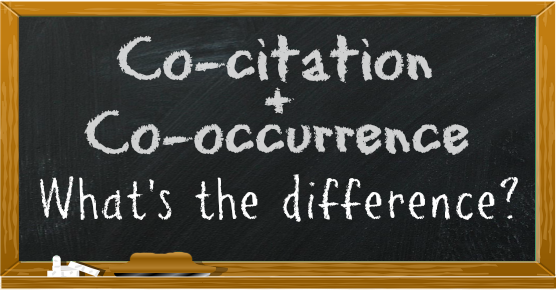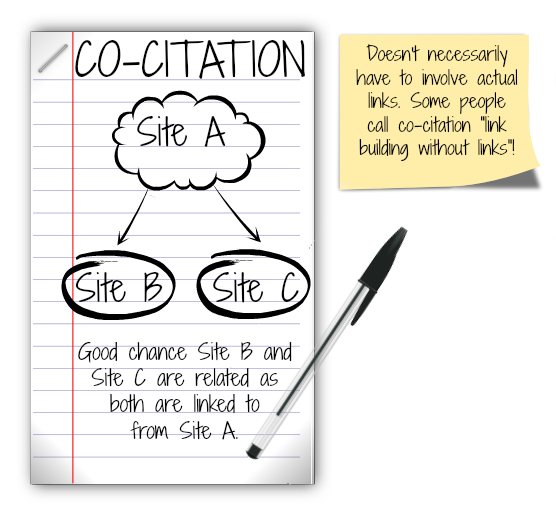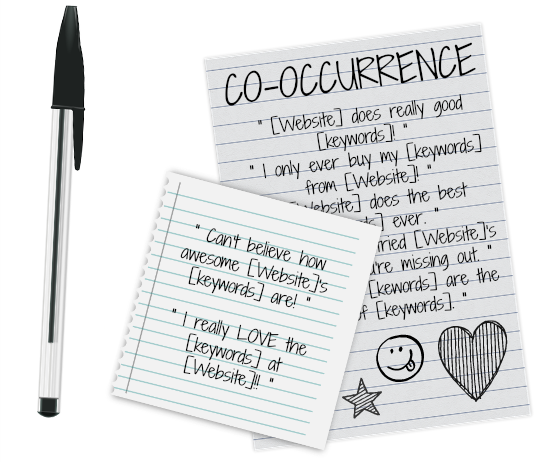
“Co-citation” and “co-occurrence” sound far more threatening than they actually are. Neither terms are particularly new to the world of SEO, but some people still get confused which is which.
What is co-citation?

A co-citation is when your website is linked or mentioned to from a web page alongside another website. If the web page linking to you is Site A, and your web page is Site B, the other web pages being linked from Site A would be Site C, Site D, and so on. So, from Google’s perspective, there’s a good chance that Site B and Site C, etc, are related as they are both linked to from Site A within context of each other.
So if a blog post were to link to a relevant page on your website as a reference (or citation), and link to another similarly relevant page on a trusted, high authority website, the co-citation from the blog post may be enough for Google to consider you both related. The more of the same co-citations , the more similar Google may consider both web pages to be. And, like the whole “bad neighbourhood”/”good neighbourhood” SEO link building metaphor, if your website frequently gets mentioned alongside all the trusted sites, Google is bound to eventually consider you as one of them. So the more Site A, Site B and Site C appear together, the stronger the relationship between the three – and if the other two websites are high authority, then this suggests to Google that you too are a credible source of information on that subject.
Furthermore, co-citation doesn’t even require there to be actual links to the pages. If two websites are cited (or mentioned) alongside each other on a web page, then Google may identify both websites or web pages as being related to each other without there even being any links.
What is co-occurrence?

Unlike co-citation, co-occurrence doesn’t just stop at websites. It can be used to create connections between keywords or phrases and your website. But co-citation is nothing to do with synonyms, which is most commonly associated with Latent Semantic Indexing in SEO. I’m not suggesting that Google considers your website to be synonymous with a keyword in the literal sense of the word, as in Google thinks they mean the same thing (like “funny” and “humorous”). Though both are now crucial to content optimisation for SEO.
For example, if your website or company/brand name frequently gets mentioned within context of a keyword or phrase, then Google will connect the two and associate your website with the keyword. Let’s say you’re an insurance broker and your company is called Awesome Horse (I don’t know…). If “Awesome Horse” frequently makes an appearance in close proximity to the word “business insurance”, Google will start making the connection and associate “Awesome Horse” with “business insurance”. Which, in time, will help to optimise your website for “business insurance” related queries in search. Without there even having to be any “business insurance” anchor text back to your website, as there would be in traditional link building. Or any mention of “business insurance” on your website (though that would just be silly…).
Co-occurrence gives websites with no knowledge of SEO the opportunity to naturally rank for terms which they are relevant for. You may not have an awesome SEO team constantly striving to optimise the website for competitive search queries based on hardcore keyword research. You might have even forgotten to put your most valuable keywords in your title or even the contents of the page. But if you become a well known brand and people are writing about you using those valuable keywords, then you can naturally start ranking for those terms that keep popping up alongside your brand name on third-party websites. And possibly even outrank those websites that have built countless links to their website using those keywords as anchor text. But!… Google might have noticed very similar words and topics mention on the website.
“Weird… Awesome Horse doesn’t mention on their website the exact phrase “business insurance”, but a lot of people seem to think that Awesome Horse has something to do with business insurance so they must be related!” – Google’s innermost thoughts.
User-generated content, such as reviews on external websites, are a great way of building up these lexical co-occurrences. If people are frequently raving on about how spicy your hot dogs are (we’ve moved on from insurance now, we’re onto hot dogs), but your website doesn’t promote its spicy hot dogs at all, you could potentially start ranking for spicy hot dogs in your local area.
In 2011, Google filed their co-occurrence patent that states in its abstract:
“A method and apparatus accesses relevant documents based on a query. A thesaurus of word vectors is formed for the words in the corpus of documents. The word vectors represent global lexical co-occurrence patterns and relationships between word neighbours.”
It goes on, as could I, but you get the point. Co-occurrence is something that everyone in SEO should be paying attention to, and could even be considered the basis of Google’s recently announced machine-learning RankBrain, which they have said to be the “third-most important signal contributing to the result of a search query”.
How do either of them help my link building?
Co-citation and co-occurrence are both smarter ways of link building, and should be taken into account in modern SEO.
Take a look at the biggest factors of what makes a “good” link:
- anchor text
- domain/page authority
- content relevance
Co-citation and co-occurrence provide a more accurate way of determining the trustworthiness of a website by looking beyond the factors, such as anchor text, that can be easily manipulated. If you put out great quality content or provide a great service, people are going to start mentioning you.
Links are still important. They’re not going anywhere any time soon. Even Yandex, the poster child of a “no links” search algorithm, reverted back to the inclusion of links as a ranking factor.
But instead of over-using exact match keyword anchor text it might be a wiser decision to use a more natural branded anchor text, allowing the surrounding content to shape the context of the link. Google’s not dumb anymore; you don’t have to tell it exactly what type of content the link is going to via the anchor text, they can pretty accurately guess the reason you’re being linked to judging by the content surrounding the link to your website and its relation to the content on your web page itself.
Keywords are still an extremely valuable component of SEO and link building. But the way in which we use them is evolving. For example, instead of always linking “Google’s search engine“, you would link “Google‘s search engine“. Not only does this result in a less spammy-looking link, you’re using co-occurrence to relate the brand/website Google to that particular keyword. But, as always, use your own instinct and common sense.

